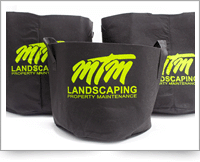FABRIC PLANTING POTS

In the previous Spring/Summer seasons, we found a way to incorporate fabric bags into our gardening routine to help keep the plants healthy and hydrated between jobs and before going in the ground. We believe in using practical and efficient tools. They have allowed the process of removing, transplanting, and storing flowers to be a lot easier while preserving the roots' life.
They are made of a preamble, breathable cloth with several benefits, coming in various sizes to accommodate plants' different kinds/sizes. The sizes we currently have in stock are the 5, 10 and 15 gallons.
Improve Your Routine
For other landscaping companies or even independent gardeners, being able to store your selection that is commonly used by clients is ideal. They are versatile and space-efficient and are great for transporting in between locations. If you're interested, you can purchase in bulk and get your logo screen printed on them.
Prevents Over-Watering
Depending on the type of plant, it may be overly thirsty for a drink, while others may prefer not to be in standing water; it can develop mould or fungus. To avoid that, we recommend using fabric because it's a breathable material; it drains with ease, leaving the soil moist enough to keep it thoroughly hydrated without drowning the roots and thus potentially killing it.
FABRIC PLANTING POTS PRICES
- 05 gal. (12 x 9.5)
- 10 gal. (16 x 11.5)
- 15 gal. (18 x 13.5)
- LOGO PRINTING
- $9.99 Each
- $11.99 Each
- $13.99 Each
- $4 Per Unit
* Based on Two Screen Printed Logos
Delivery Available In:
Richmond Hill, King City, Aurora, Newmarket, Nobleton, Schomberg, Toronto (North York - East York), Brampton, Mississauga and the surrounding GTA

Temperature Control
During the hot summer months, any flowers sitting in a plastic or ceramic pot are likely to retain much heat from the sun, and while those may seem like the best option, it can put them at risk. A good majority of plants are sensitive to temperature change, and pots made of plastic material can become a sort of like a mini-oven, which can overheat the roots from the inside, causing it to wilt and die eventually.
Whether the plants are in the fabric bags for a short or long period, the material won't retain heat the same way traditional pots do. The material bags allow for good air circulation, cooling down the soil, and letting the heat escape from every angle; this way, you're avoiding excessive heat.
Steps of Preventing Shock
Before transplanting any of your plants, it's essential to be aware of the potential damage you could cause in the process. A common reason plants can or may go into shock while being transplanted is due to the various changes. Changing soil to drastic temperature changes, over or underexposed to direct sunlight and the amount of moisture it has are all potential causes. There are a few key steps you can take To ensure this doesn't happen!
The first step is to give the plant you're moving a good drink ahead of time. Before or even as early as possible on the day of transplanting, you could allow the dirt to soften and water to soak into the roots. The whole plant should be well-hydrated when it comes time to transplant it. We recommend doing this during the cooler evening hours; that way, it can adjust overnight to its new home before being exposed to daylight and heat.
Be sure to give it a little more water before you dig to remove it; the goal is to make sure the soil around the roots adheres to them to not be in any drying winds. Place the plant into the bag and at the bottom of the bag, make sure to put some good rich soil at the bottom of the outdoor garden pot.
Lastly, fill the bag with more dirt to cover the roots and wet it once more. If it's a hotter day when you're doing the transplant, the water can evaporate a lot quicker, so keep in mind, it's best to try and do this in cooler temperatures or later in the day.
After Using Planting Pots to Transplant Flowers
For the next couple of weeks after the transplant, make sure to check on it daily. Check the soil a few inches below the surface for dryness because it may need watering more often until it has settled into its new home. Consider the type of weather and the type of plant it is as well: the larger the plant, the more it'll need. You'll also want to keep it out of direct sunlight for the next couple of days, as it'll dry it out much faster that way.

